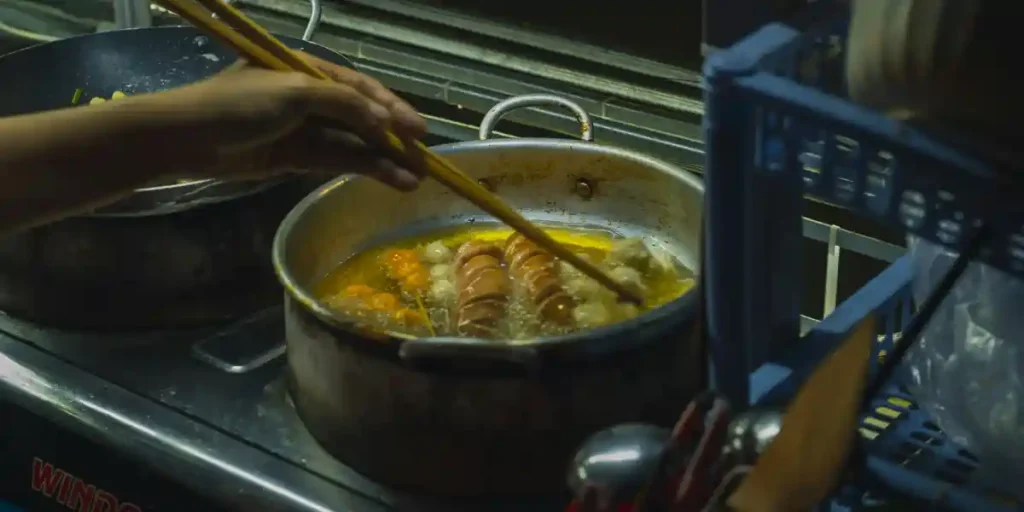Vietnam, a land of breathtaking landscapes and rich cultural heritage, is also a paradise for food lovers. Exploring the Vietnamese street food offers an unparalleled culinary experience. Whether you’re wandering through bustling cities or exploring quiet villages, the aromas of sizzling dishes and freshly cooked delicacies will tempt your senses. Let’s dive into the vibrant world of Vietnamese street food, exploring its diverse offerings, regional specialties, and the stories behind these delicious bites.
The Essence of Vietnamese Street Food
Street food in Vietnam is more than just a quick bite; it’s a way of life. It reflects the country’s history, culture, and communal spirit. The streets of Vietnam are lined with food stalls and vendors, each offering a unique taste of the region. From Hanoi’s busy alleys to Ho Chi Minh City’s lively markets, street food is an integral part of Vietnamese daily life.
Pho: The Quintessential Vietnamese Dish
When talking about street food in Vietnam, Pho is a must-mention. This aromatic noodle soup is a staple breakfast dish but can be enjoyed any time of day. Pho consists of a flavorful broth, flat rice noodles, herbs, and either beef (Pho Bo) or chicken (Pho Ga). The secret to an exceptional Pho lies in its broth, simmered for hours with bones, cinnamon, star anise, and other spices. Topped with fresh herbs and a squeeze of lime, it’s a comforting and delicious meal.
Banh Mi: A Fusion of Cultures
Banh Mi is a perfect example of how street food in Vietnam blends different culinary traditions. This sandwich combines a French baguette with Vietnamese fillings, a legacy of French colonial influence. The crusty bread is filled with a variety of ingredients such as pate, grilled pork, pickled vegetables, fresh cilantro, and chili. Each bite offers a delightful mix of textures and flavors, making Banh Mi a favorite among locals and tourists alike.
Goi Cuon: Fresh and Healthy Rolls
For a lighter option, Goi Cuon, or fresh spring rolls, are an excellent choice. These translucent rolls are made with rice paper and filled with shrimp, pork, vermicelli noodles, and fresh herbs. They are served with a peanut dipping sauce that adds a savory and slightly sweet element. Goi Cuon is not only delicious but also a healthy option, showcasing the balance of flavors and textures typical of Vietnamese cuisine.
Bun Cha: A Hanoi Specialty
Bun Cha is a beloved dish from Hanoi, featuring grilled pork patties and slices served with vermicelli noodles, fresh herbs, and a tangy dipping sauce. They marinate and grill the pork to perfection, imparting a smoky flavor that pairs beautifully with the fresh herbs and noodles. Eating Bun Cha is an interactive experience; you can mix the ingredients to your liking, creating a personalized and satisfying meal.
Banh Xeo: Vietnamese Savory Pancakes
Banh Xeo, meaning ‘sizzling cake,’ features a crispy pancake made from rice flour, turmeric, and coconut milk. Vendors fill it with shrimp, pork, and bean sprouts, then fold it in half and serve it with fresh herbs and a dipping sauce. The contrast between the crispy pancake and the soft, savory filling makes Banh Xeo a delightful treat. Often enjoyed with a group, it’s a dish that brings people together.
Che: Sweet Endings
No exploration of street food in Vietnam would be complete without trying Che, a traditional Vietnamese dessert. Che comes in many forms, from sweet soups to puddings, often made with beans, sticky rice, fruits, and coconut milk. Served hot or cold, Che offers a refreshing and sweet end to any meal. Each region in Vietnam has its own variations, making it a diverse and delightful dessert to explore.
Regional Street Food Specialties
Vietnam’s diverse geography and cultural influences have given rise to regional street food specialties. Each region offers unique dishes that reflect local ingredients and traditions.
Northern Vietnam
In Northern Vietnam, the cuisine is prominent for its use of fresh herbs and minimal use of spices. Hanoi, the capital, is a great place to explore Northern Vietnamese street food. Besides Pho and Bun Cha, don’t miss out on
- Xoi Xeo: Sticky rice topped with mung bean, fried shallots, and often served with a side of pork or chicken.
- Nem Ran/Ca (Spring Rolls): Fried spring rolls filled with minced pork, mushrooms, and vermicelli.
Central Vietnam
Central Vietnam is famous for its bold and spicy flavors. The ancient town of Hoi An and the imperial city of Hue are culinary hotspots. Notable dishes include:
- Mi Quang: A turmeric-infused noodle dish topped with shrimp, pork, peanuts, and fresh herbs, served with a small amount of broth.
- Banh Beo: Small steamed rice cakes topped with dried shrimp, crispy shallots, and a savory sauce.
Southern Vietnam
Southern Vietnamese cuisine is sweeter and incorporates more coconut milk. Ho Chi Minh City is the place to savor the best of Southern street food, such as:
- Hu Tieu: A noodle soup with a clear and sweet broth, topped with pork, shrimp, and a variety of vegetables.
- Banh Trang Nuong: Often referred to as Vietnamese pizza, this grilled rice paper is topped with egg, minced pork, and various other toppings.

Exploring Vietnam’s Food Markets
Vietnam’s food markets are vibrant and bustling hubs of activity, offering a sensory feast of sights, sounds, and smells. Visiting these markets provides a glimpse into the daily life of locals and an opportunity to sample fresh and authentic food and drink.
Ben Thanh Market in Ho Chi Minh City
Ben Thanh Market is one of the most famous markets in Vietnam. Located in the heart of Ho Chi Minh City, this market is a bustling maze of stalls selling everything from fresh produce to souvenirs. The food court offers a wide variety of Vietnamese dishes, making it a great place to try different foods in one location.
Dong Xuan Market in Hanoi
Dong Xuan Market is Hanoi’s largest indoor market. Situated in the Old Quarter, this market is a bustling hub of activity and a must-visit for food lovers. A historic building with a distinctive Soviet-style facade, and interior houses the market .You’ll find a labyrinth of stalls offering everything from fresh produce to souvenirs.
Food and Drink at Dong Xuan Market
One of the main attractions of Dong Xuan Market is its vibrant food court. Here, you can sample a variety of traditional Vietnamese dishes and beverages. Some of the must-try items include:
- Bun Rieu: A tangy tomato-based noodle soup with crab and tofu.
- Nem Ran: Vietnamese spring rolls, crispy and packed with flavorful fillings.
- Che: A selection of sweet soups and puddings made with ingredients like beans, coconut milk, and fruit.
- Tra Da: Refreshing iced tea that’s perfect for quenching your thirst as you explore.
The market is a sensory overload, with the aromas of spices and cooked food mingling in the air. It’s a fantastic place to experience the local food culture and try dishes you might not find elsewhere.
Shopping and Exploring
Beyond the food, Dong Xuan Market offers a wide array of goods, from clothing and accessories to household items and electronics. It’s a great spot to pick up souvenirs and gifts, such as traditional Vietnamese handicrafts, silk garments, and lacquerware. The market can be crowded, especially during weekends, so be prepared to navigate through bustling aisles.
Tips for Visiting Dong Xuan Market
- Go Early: To avoid the heaviest crowds, visit in the morning.
- Bargain: Haggling is common, so don’t hesitate to negotiate prices.
- Stay Hydrated: The market can be hot and stuffy, so keep a bottle of water handy.
- Watch Your Belongings: As with any crowded market, be mindful of your valuables.
Visiting Dong Xuan Market is an essential part of any trip to Hanoi. It provides a fascinating glimpse into local life and a chance to indulge in some of the best food and drink Vietnam has to offer.
Tips for Enjoying Street Food in Vietnam
Hygiene and Safety
While street food is delicious, it’s important to be mindful of hygiene. Choose vendors with high turnover, as this often indicates fresher ingredients. Look for places where locals eat, as they know the best spots. Carry hand sanitizer and avoid eating raw or undercooked food to minimize the risk of foodborne illnesses.
Embrace the Experience
Part of the charm of eating street food in Vietnam is the experience. Don’t be afraid to sit on tiny plastic stools and share a table with strangers. Interact with the vendors and fellow diners; these moments add to the richness of your culinary adventure.
Be Adventurous
Vietnamese street food offers a vast array of flavors and textures. Don’t hesitate to try unfamiliar dishes. Some of the best culinary discoveries come from stepping out of your comfort zone. From savory snacks to sweet desserts, every bite tells a story.
Learn Basic Vietnamese Phrases
Learning a few basic Vietnamese phrases can enhance your street food experience. Simple greetings and thank yous go a long way. Phrases like “cho toi mot” (please give me one) or “cam on” (thank you) can help you connect with vendors and show your appreciation for their delicious creations.
Bargain Wisely
While most street food is reasonably priced, it’s common to bargain at markets. Do so politely and with a smile. It’s part of the cultural exchange and can be a fun way to interact with locals.
The Cultural Significance of Vietnamese Street Food
Street food in Vietnam is not just about satisfying hunger.It bounds the country’s social fabric. It’s a reflection of the resourcefulness and creativity of the Vietnamese people. Through centuries of history, from the times of dynasties to colonial rule and wars, Vietnamese cuisine has evolved, incorporating influences from various cultures while retaining its unique identity.
Social Hub
Street food stalls and markets serve as social hubs where people gather to eat, chat, and share stories. They are places where communities bond over food. This communal aspect of dining is a vital part of Vietnamese culture, emphasizing the importance of relationships and shared experiences.
Economic Livelihood
For many Vietnamese, street food vending is a crucial source of income. These small businesses support families and contribute to the local economy. By enjoying street food, you’re directly supporting the hardworking vendors who bring these delicious dishes to life.
Final Thoughts about Vietnamese Street food
In conclusion, the street food of Vietnam is an unforgettable journey. It’s a sensory adventure filled with vibrant colors, enticing aromas, and mouth-watering flavors. Every dish tells a story, from the bustling streets of Hanoi to the serene countryside of Central Vietnam. By embracing the street food culture, you not only taste the essence of Vietnamese cuisine but also connect with its people and their traditions. So, pack your bags, bring your appetite, and get ready to embark on a culinary adventure through the heart of Vietnam.



